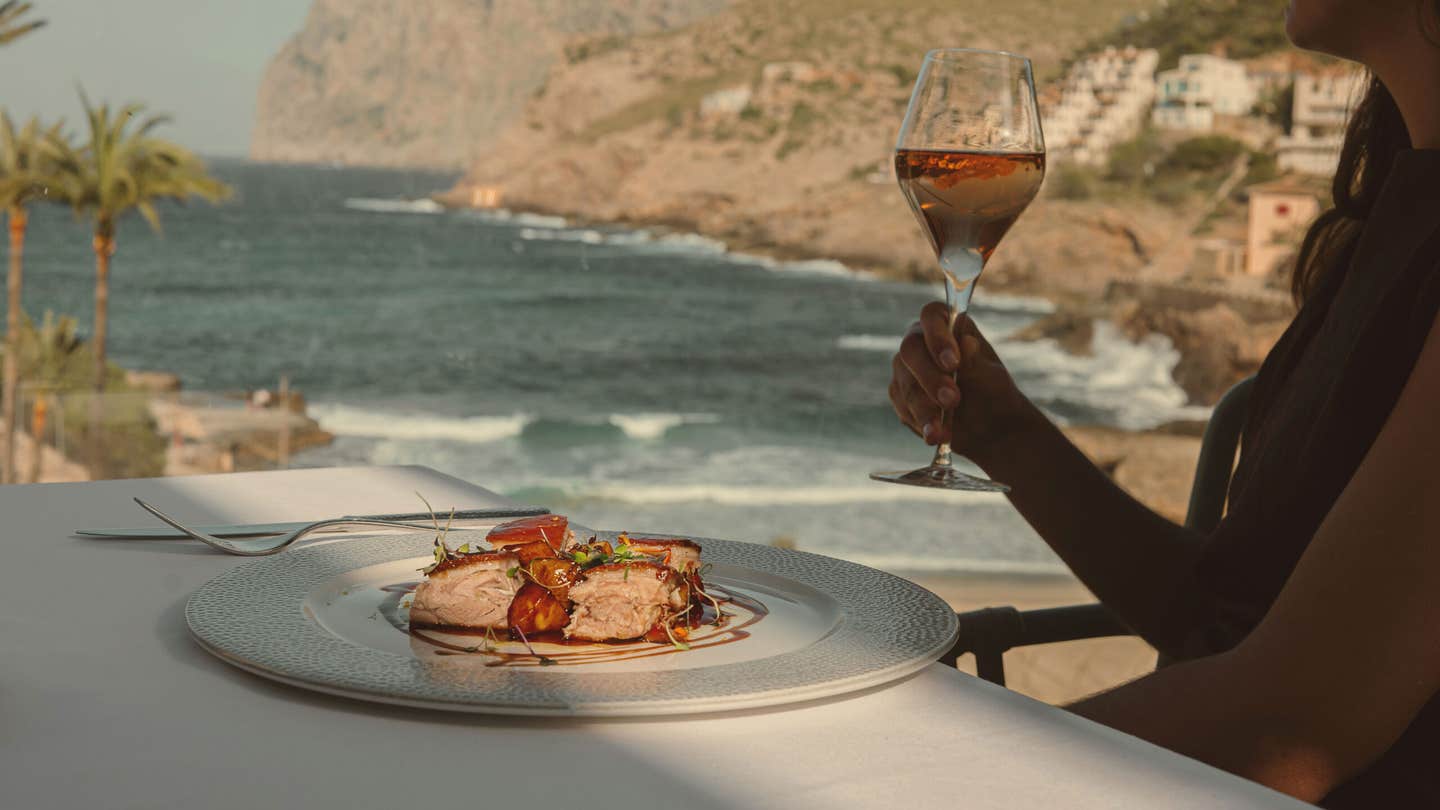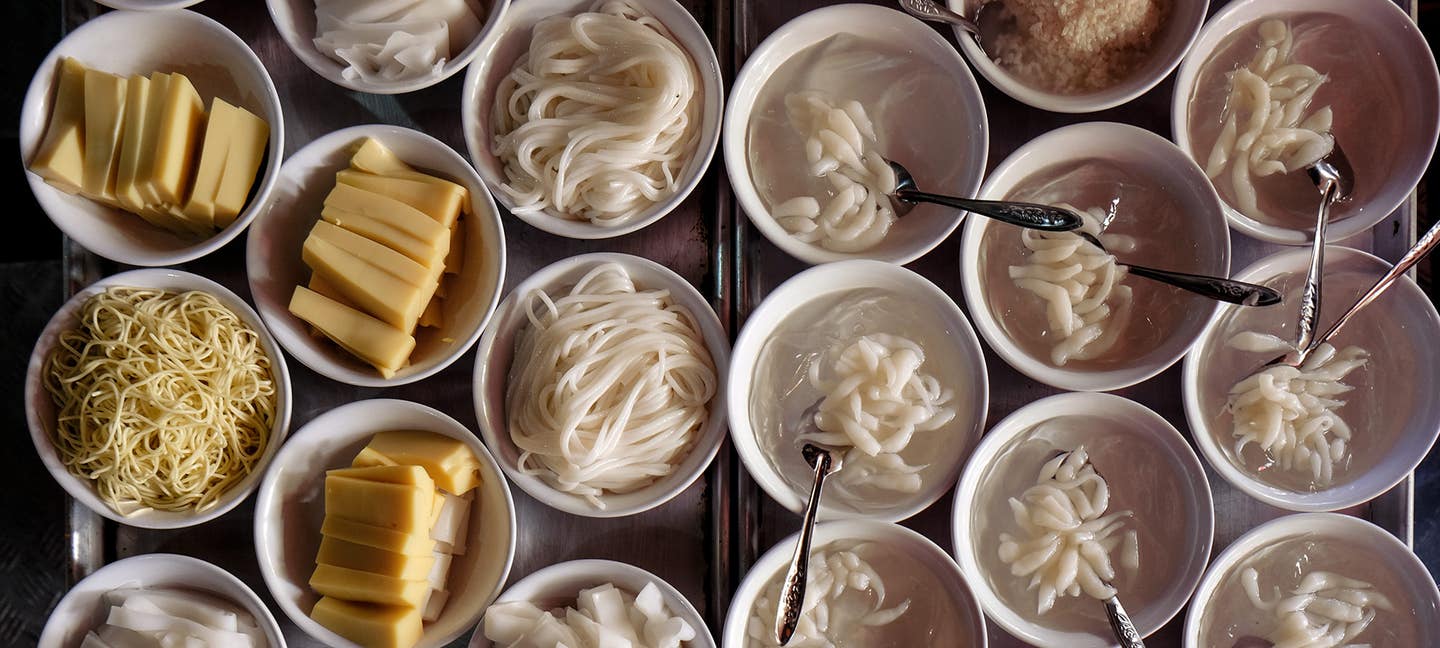
On the Hunt for Yunnan-Style Rice Cakes
Almost unheard of outside of China, Yunnan’s traditional erkuai rice cakes lure a writer back to the province on a fact-finding mission
The erkuai bao youtiao lady comes to Luofeng Street every morning. She sets up her cart across from the elementary school and begins grilling round tortilla-like pieces of erkuai, a tender rice cake that is a beloved specialty here in Yunnan, China's southwesternmost province.
First she toasts each piece over homemade charcoal, carefully flipping them until they are hot and blistered all around. Then she slathers each with sauce—either a spicy paste made from fermented beans and chiles, or one made from a mix of ground sesame seeds and peanuts. Finally, she wraps the erkuai around a youtiao, a long piece of fried dough, and pops it into a small plastic bag. (The bag is so thin, you have to hold it by its tiny handles, as if you were carrying a doll's purse, to keep from burning your fingers.) Erkuai bao youtiao is a popular breakfast here, and a bag costs less than a dollar.
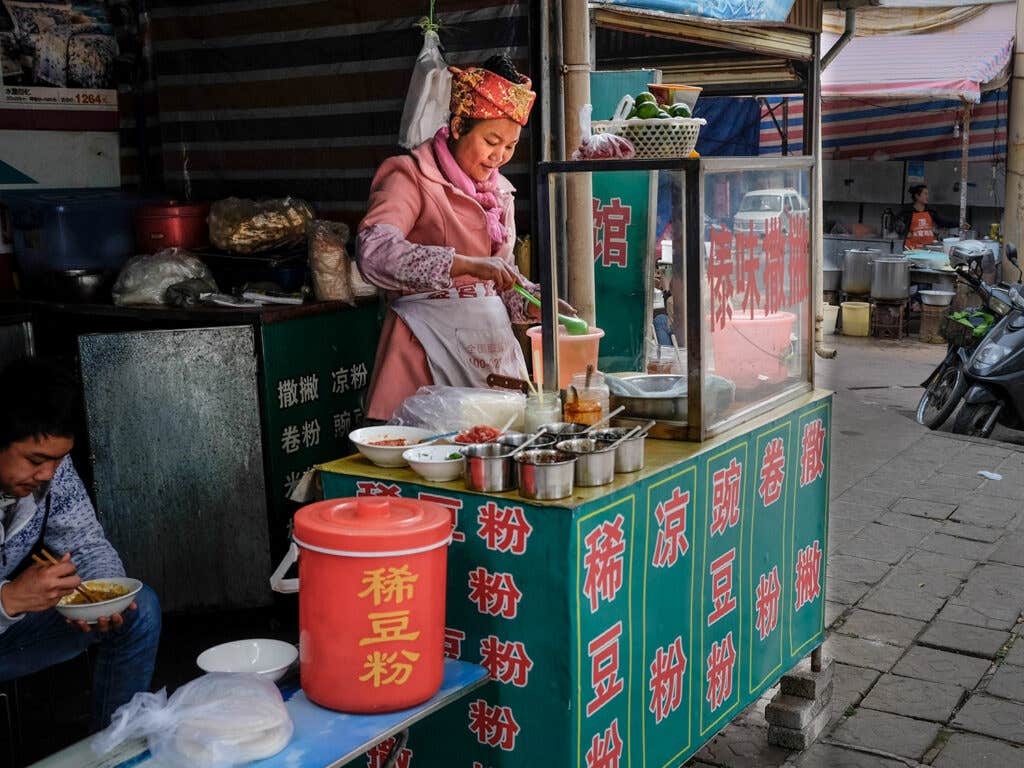
Six years ago, I lived on this block, in a sixth-floor walk-up with ornate wooden window screens that framed the pulsating rainbow LED lights of a small hotel across the street. Every morning my husband would pop down to the corner (if anyone can “pop” down six flights of cold concrete stairs) and pick up these treats for us, which go surprisingly well with coffee.
Erkuai is an ingredient made from local varieties of rice that is steamed, ground, or pounded, then kneaded and pressed by hand until it is dense and firm. This simple base can then be used in a surprisingly wide variety of ways: rolled into thin circles and grilled over embers, cut into cubes and deep-fried, or stir-fried in thin triangular slices. It can also be shredded into long, noodle-like strands, called ersi, that can be stir-fried or added to soup. In its many incarnations, erkuai is one of the most popular ingredients in Yunnan. A standard in every restaurant and home in the city, it's served in various forms for breakfast, lunch, snacks, and dinner.
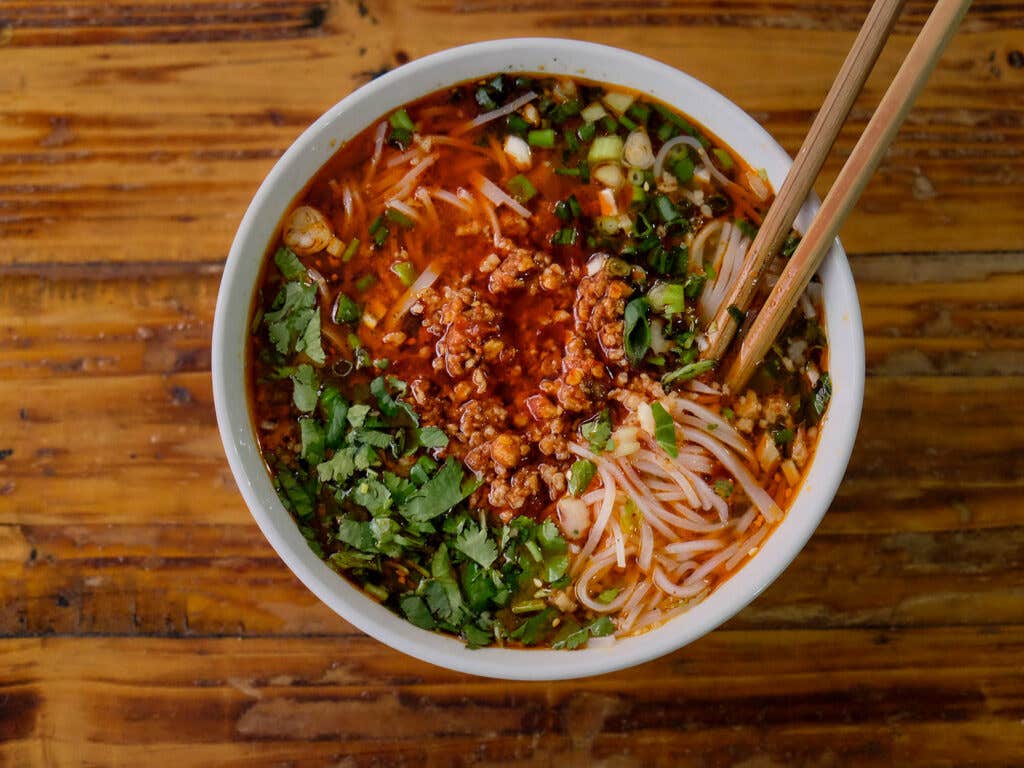
On Luofeng Street alone, there are half a dozen ways to eat erkuai. Street vendors and small shops sell the grilled circles for breakfast. For lunch, noodle shops boil thin ersi and add them to soups with stewed meat, chile-bean sauce, and numbing Sichuan peppercorns. At dinner, restaurants cut erkuai into thin slices to stir-fry with combinations like pork and scallions or a mix of vegetables and serve it alongside local classics such as steam-pot chicken with goji berries and xiao chao rou (stir-fried pork with garlic chives). When I lived in Yunnan, I used to eat erkuai in some form almost every day.
Rice cakes are not unique to Yunnan. Versions made from sticky rice are found everywhere from Korea (tteok) to southern China (nian gao) to Japan (mochi). But because Yunnan's erkuai is not made with sticky rice, it is tender and toothsome rather than sticky and chewy, and therefore the dough can be used in far more ways and cut into far more shapes. Despite erkuai's simplicity and versatility, I've never seen it outside Yunnan. When I moved back to the U.S., erkuai was one of the things I missed most. I had heard about how it was made, and it didn't sound particularly complicated. So while traveling in Yunnan doing research for my book Cooking South of the Clouds, I set out to learn more about the history, try its most famous incarnations, and hopefully learn to make erkuai at home.
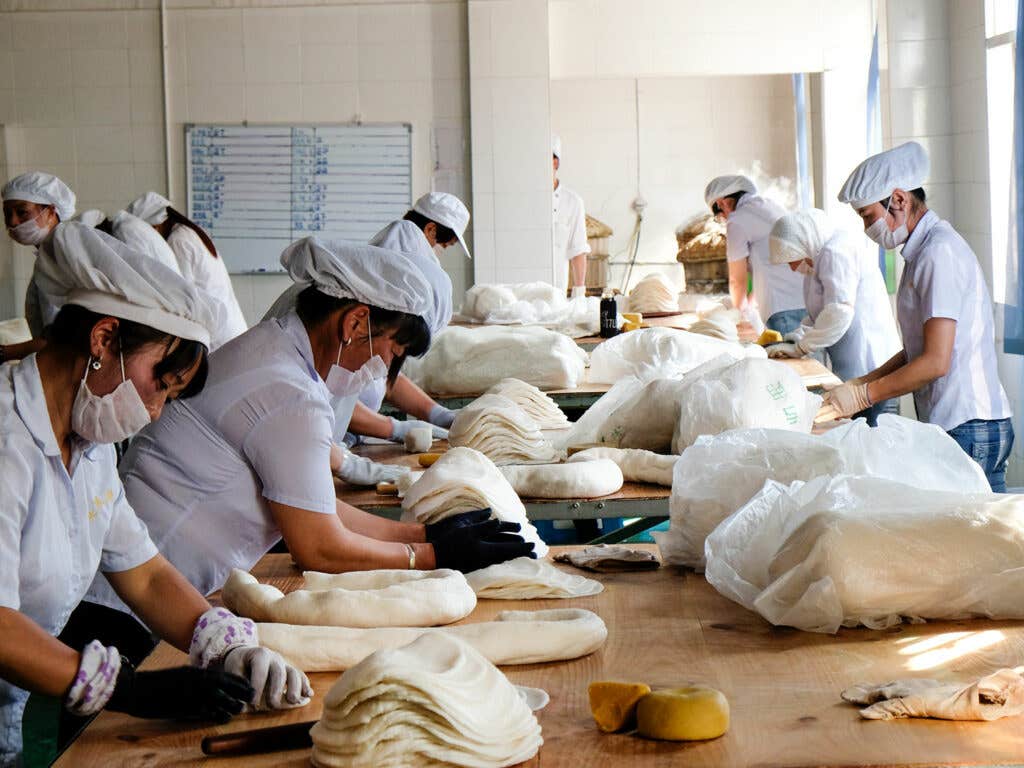
I began my journey in Guandu Ancient Town, just south of Kunming, near Dianchi, China’s sixth-largest freshwater lake. The town was an important trading center during the Tang Dynasty (618–907), where boats crossing Dianchi unloaded goods. These days, Guandu is a tourist destination filled with souvenir shops and restaurants. It is also home to the Guandu Erkuai Techniques Exhibition Center, which was opened in 2011 to demonstrate and preserve the traditional way of making the rice cakes.
At the center, I met up with founder and director Yang Yong, who let me peek into the exhibit, an old-style erkuai-making facility that has a large glass wall so visitors can watch the process. The setup has the feeling of a museum diorama come to life, with employees dressed in traditional local clothing—bright blue jackets and black vests. Yang showed me the steaming station, a series of wooden baskets set over wood-fired woks, then moved on to the main attraction, the mudui. This contraption is made up of a 12-foot log lodged into a stone wedge that holds it about a foot off the floor, making the whole thing into a kind of seesaw. One end of the log has a thick piece of wood sticking out of it toward the floor, and below it is a sturdy stone basin. All together, it acts like a massive mortar and pestle.
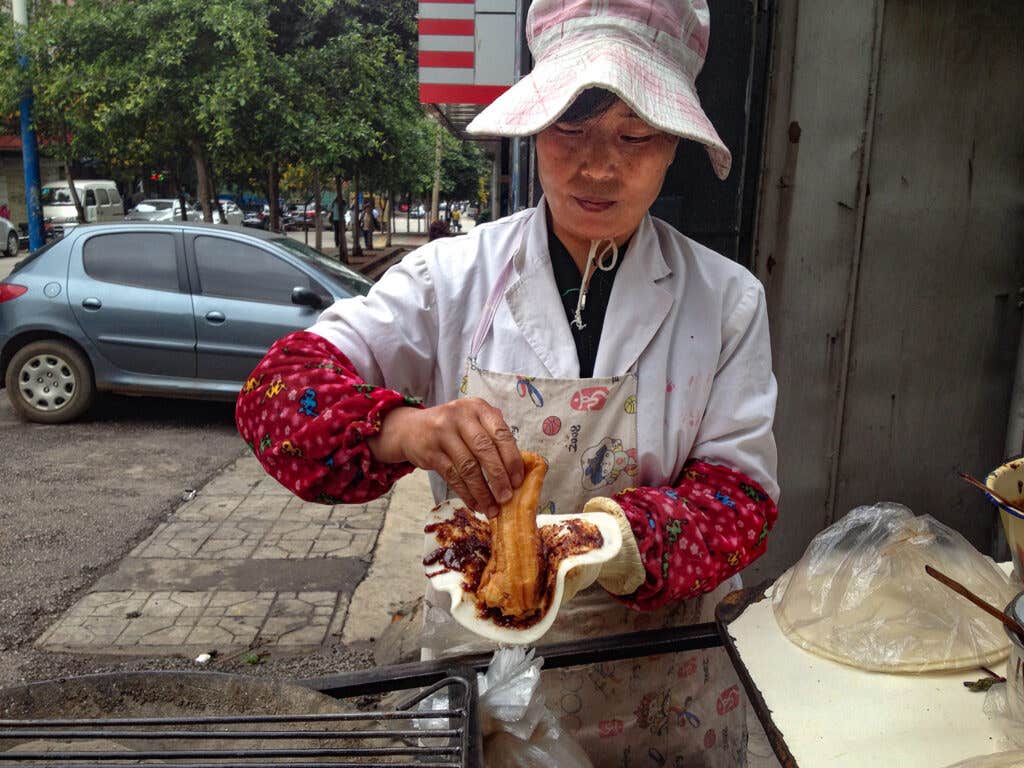
To make erkuai, cooks there steam rice in big wooden buckets, then dump the hot rice into the basin. A handful of employees—all men—stomp on the end of the log to activate the pestle-like action. Once the rice is thoroughly mashed, the cooks knead it into oblong loaves, roughly 5-by-9 inches, and put them onto shelves lined with bamboo mats to firm up.
Erkuai has been eaten in this part of Yunnan for around 400 years. There are lots of stories about how erkuai came to the area, but Yang thinks the most reliable is that it arrived with soldiers from central China. “The main reason it became so popular is that it’s easy to carry,” he explained. “Soldiers could take it out and heat it or roast it when they needed to.” Those same qualities made the ingredient popular in Guandu: “Residents around here were all fishermen, and erkuai was convenient for them to bring out on the boats and heat on a little stove,” Yang said. According to local lore, if your wooden fishing boat suddenly sprang a leak, you could even make a patch with erkuai that would hold up well enough to get you back to dry land.
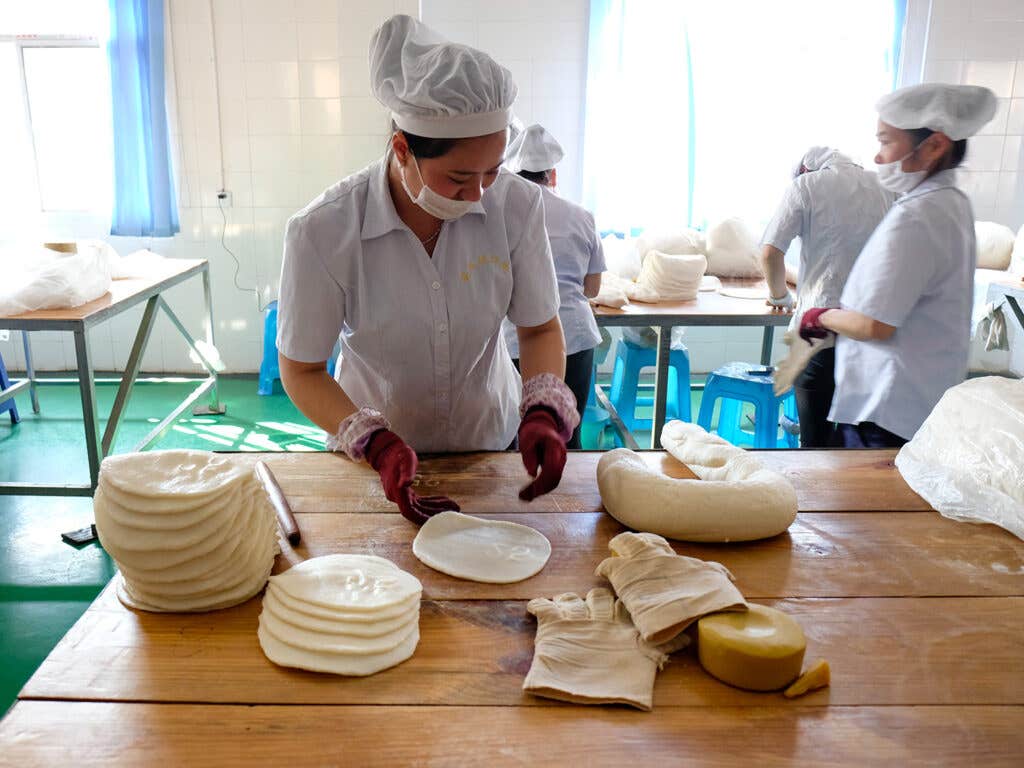
After learning about erkuai's origins, I wanted to study its most famous preparation, a dish called dajiujia. So I headed to Tengchong, a city in western Yunnan, on China's border with Myanmar, to try it at the source.
Tengchong sits less than 45 miles from Kachin State in Myanmar, on the western edge of China, nearly 1,500 miles from Beijing. For more than two centuries, the region was a major border crossing on the Tea Horse Road, a network of trade routes also known as the Southern Silk Road that crossed Yunnan, connecting Tibet to China and Southeast Asia and central China to Myanmar and India.
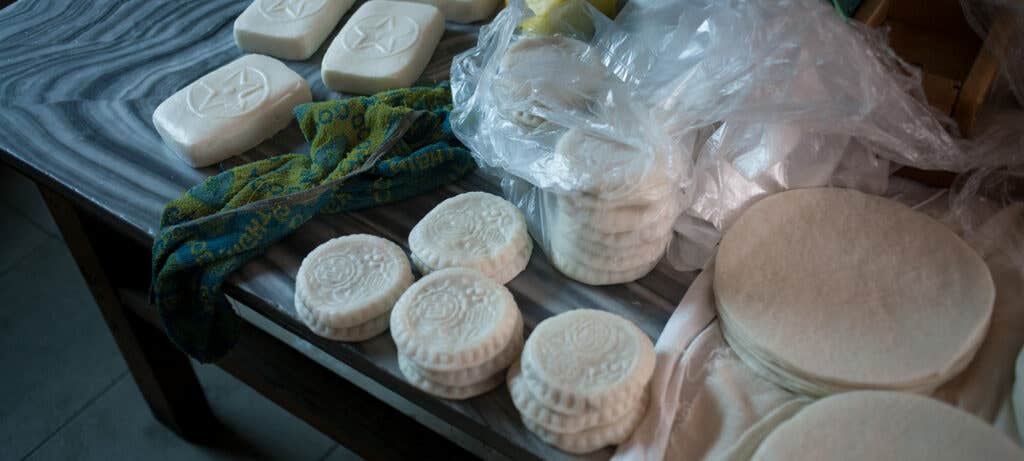
For much of that time, trade went through the town of Heshun, a collection of ornate Qing Dynasty stone houses.
Today, the town has been updated to appeal to travelers and is full of guesthouses and shops. Many of Yunnan’s most picturesque towns have received this treatment in the past 20 years or so, as the province has transformed from a little-known backwater to a desirable vacation spot. When I arrived in town, the rapeseed fields just outside town were in bloom, and dozens of tourists were posed among the golden flowers, selfie sticks aloft.
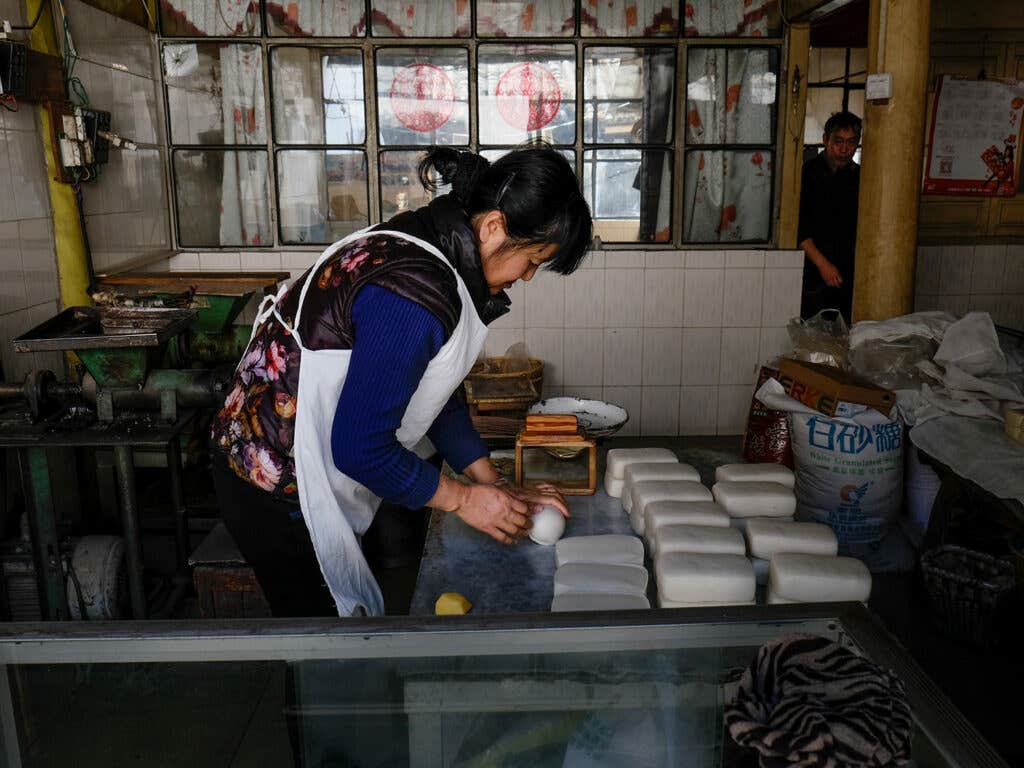
Locals still travel relatively freely between Tengchong and Myanmar today, and some cross-border commerce was evident in Heshun's main food market, where Burmese ladies with golden thanaka paste on their cheeks and foreheads sold freshly foraged greens and bowls of pickled wild hawthorn covered in dried chiles. A few blocks away, locals snacked on a dish that is as popular across the border as it is in western Yunnan: xidoufen ban ersi, or golden pea porridge mixed with either rice noodles or ersi. Handfuls of boiled ersi are served in paper bowls and topped with a scoop of xidoufen, a mixture made from ground yellow peas. The vendors offer half a dozen toppings, including scallions, cilantro, chopped tomato, peanuts, sesame seeds, and an aromatic oil made from ginger, black cardamom, star anise, and Sichuan peppercorns. Customers take home bowls or head to low folding tables in the alley to eat.
But as my mission was dajiujia, I made my way to a restaurant I had heard about in the countryside called Jing Nong Zhuang, or “Golden Farm,” to meet with a local guide named Bing Li. The reason dajiujia is so famous, she told me, is its origin story. According to legend, in 1661, the emperor Zhu Youlang was fleeing from the Manchus and took refuge in the city. He arrived in Tengchong tired and hungry, and a cook quickly stir-fried some erkuai with the ingredients he had on hand. Zhu ate the dish gratefully and decreed it would be called “dajiujia,” or “saving the life of the emperor.” The recipe varies a bit from cook to cook, but it always includes pork, egg, tomatoes, and some kind of greens. The version served at the restaurant included fatty pork belly, egg, tomatoes, spinach, and sliced mushrooms. It was, indeed, a spectacular combination, but what was most striking to me was the texture of the erkuai itself. The slices were much denser and firmer than any I had had in other parts of Yunnan, without the springiness and tenderness I’d always been drawn to. Curious about the difference, and wanting to know more about how erkuai is produced today, I tracked down a small factory in the town of Dali, another center of erkuai production.
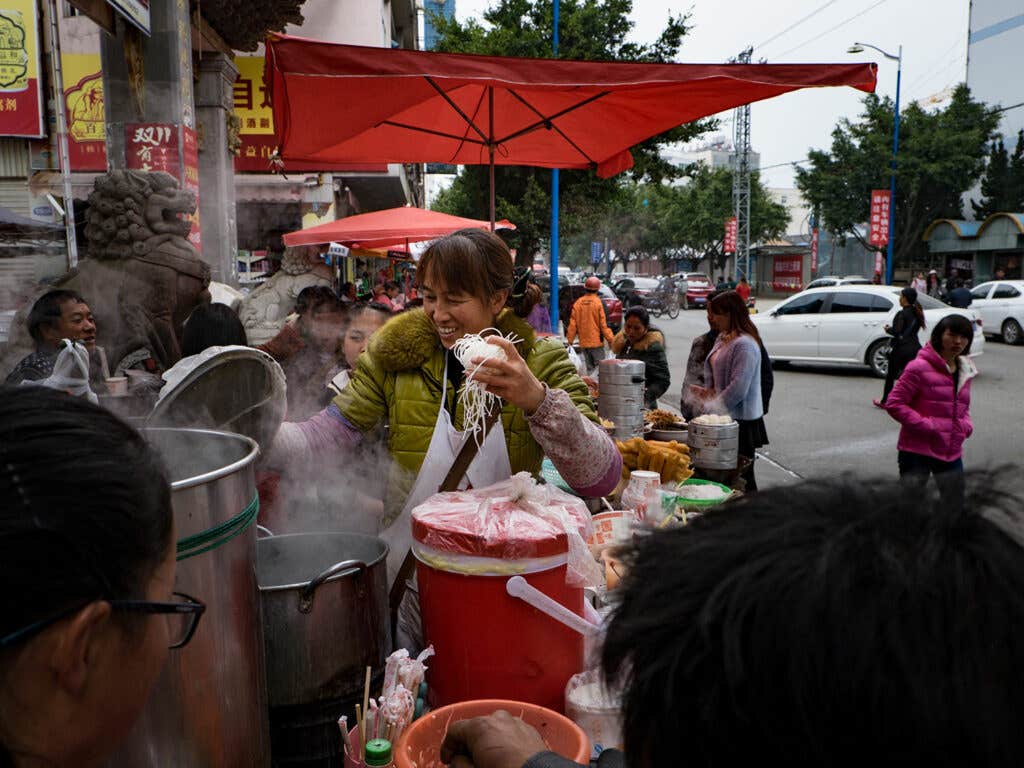
The factory of the Dali Zhao Family Dingcheng Food Factory is a few miles from Dali, surrounded by fields. In a large courtyard, I met Zao Dingcheng, a young man in his early 30s, who had offered us a tour of his facility. Zao’s family has been making erkuai here for a century, and he is the fifth generation of his family to run the business. He began working for his father at 16, and now that he is in charge, he has expanded and modernized with new equipment.
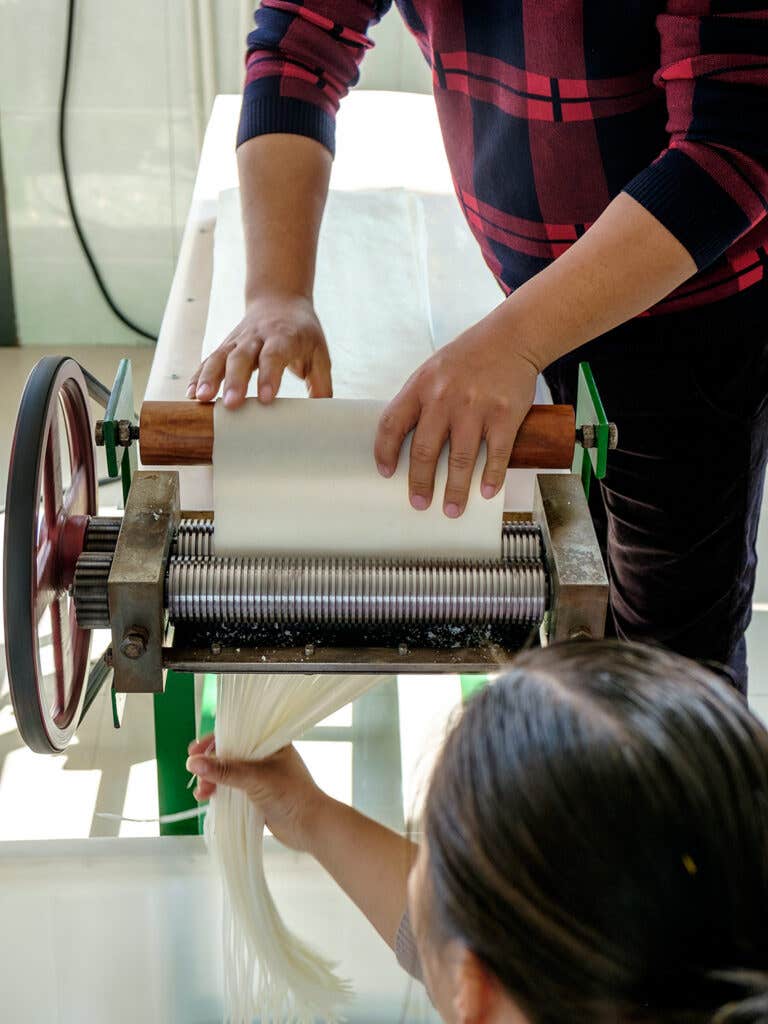
Zao pulled on rubber boots and took me into the workshop. Inside the factory, a few workers were preparing rice, soaking it in a trough then steaming it in large bamboo baskets set over vents that release jets of steam. The heat and moisture are powerful enough to cook more than 650 pounds of rice at one time. Once it was cooked, the workers fed the rice into specially made grinders that turned it into a smooth dough. They kneaded it, still steaming, until it had the texture of soft clay. Lastly, they pressed the mixture into small loaves, and rolled it out into thin circles or fed it into a large machine that flattened it into sheets to make noodle-like ersi.
Zao offered me a taste of the freshly made erkuai and pulled a handful of dough from a still-warm batch. The dough was wonderful—softer and more tender than any I had eaten in the past, with a subtle, sweet flavor from the rice. As much as I loved all of the versions of erkuai I’d tasted over the years, the fresh stuff was a revelation. The difference between this and the versions I’d had in Guandu and Tengchong came from the rice, Zao explained. Each region uses a variety of white rice that grows well in that climate, and as a result, locals have become partial to their particular style of the stuff: Cooks in Tengchong prefer hard cakes that remain very firm when cooked, while cooks in Dali are partial to a softer, chewier style. The erkuai I’d gotten used to in Kunming and the surrounding areas was texturally somewhere in between.
After the tour, Zao took me to his office and showed me documents related to the history of erkuai. Like Heshun, he told me, Dali was also a major trading center on Tea Horse Road, frequented by mule caravans loaded with tea, salt, precious metals, tobacco, spices, silks, and other valuable goods. Erkuai was particularly popular with traders and merchants along the Tea Horse Road. Anyone who did business along this route would have been familiar with the ingredient. But at the time, erkuai was relatively difficult to make, requiring the kind of time-consuming labor I’d seen in Guandu. Ersi was even trickier because you first had to make loaves of erkuai, dry them, and then painstakingly cut them into thin slices and, from there, into strips. The process was arduous enough that the ingredient was mostly made at home in small batches for individual meals.
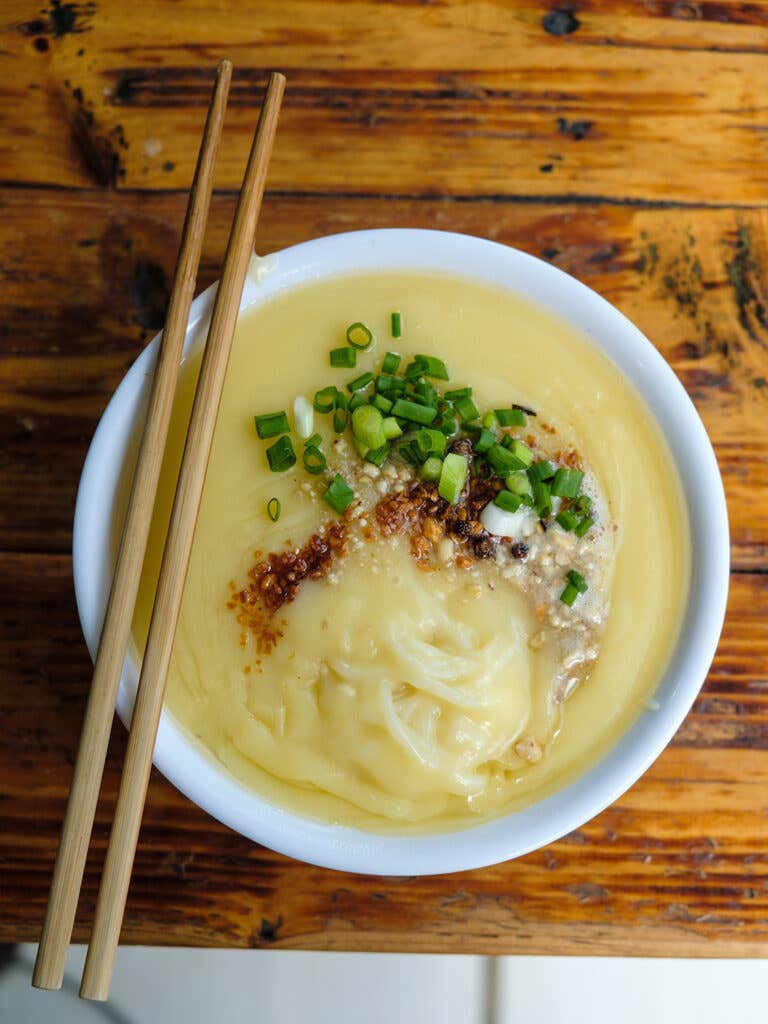
Today, thanks to the new machines I'd seen, ersi is actually easier to make than other forms of erkuai because the process is almost entirely automated: The machine rolls the dough flat, and all you have to do is feed it into a shredder reminiscent of an Italian pasta cutter. Using this new system, Zao can make up to 6 tons of ersi per day.

That afternoon, I wandered through Old Town Dali, looking for as many preparations of ersi as I could find. The most classic here is lushan pa rou ersi, a soup topped with meltingly tender stewed pork shoulder and finely chopped pork belly cooked with chiles. In the center of town, at an eatery packed with families tucking into large bowls, I ordered zhu ersi (boiled ersi), a soup topped with a spicy sauce of beef cooked in chile-bean paste, lightly pickled mustard greens and daikon, and fragrant garlic chives. The spicy, umami-laden flavors permeated the broth and clung to the springy boiled noodles, leaving my lips tingling wonderfully with chile and the faint numbing feeling of Sichuan peppercorns.
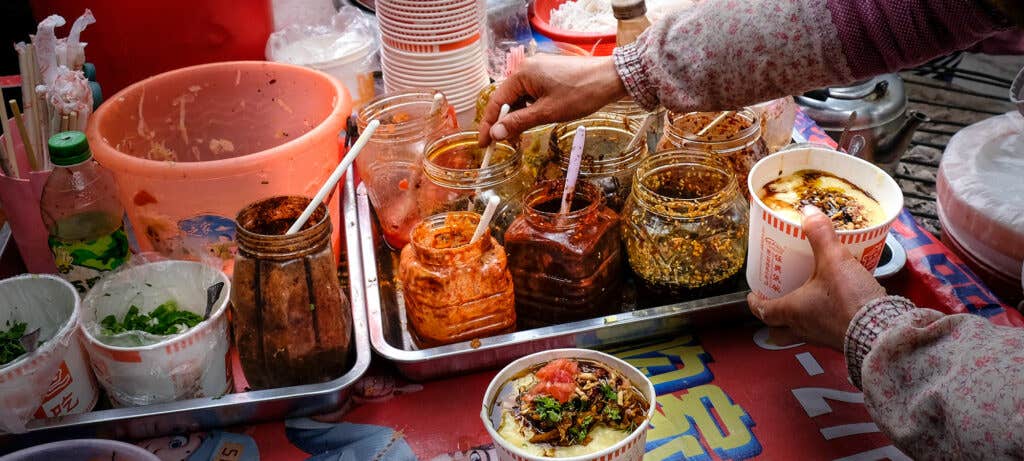
Erkuai, however, is more difficult to make at home than I had initially hoped. The grinding can easily wear out home kitchen equipment, and the subtle range of textures can be hard to reproduce. Plus, the traditional rice is not widely available in the U.S. Was this process why erkuai hadn't spread across China and the world despite all the centuries that it had been a staple for traders and merchants? Or was it actually due to Yunnan's distance from China's centers of power? Perhaps both. But recently, other foods that used to be considered hyperregional—such as northern China's crêpe-like jianbing and Sichuan's chile-covered crayfish—have jumped their traditional boundaries and made it big across the country. Some of Yunnan's other dishes, including "crossing the bridge rice noodles," are starting to become trendy in Shanghai, Beijing, and even New York. Surely if selfie-stick-wielding tourists posted pictures of themselves eating erkuai, others would want to try it too. Now that producers can make it much more easily, and Yunnan has become a popular destination, is erkuai next?
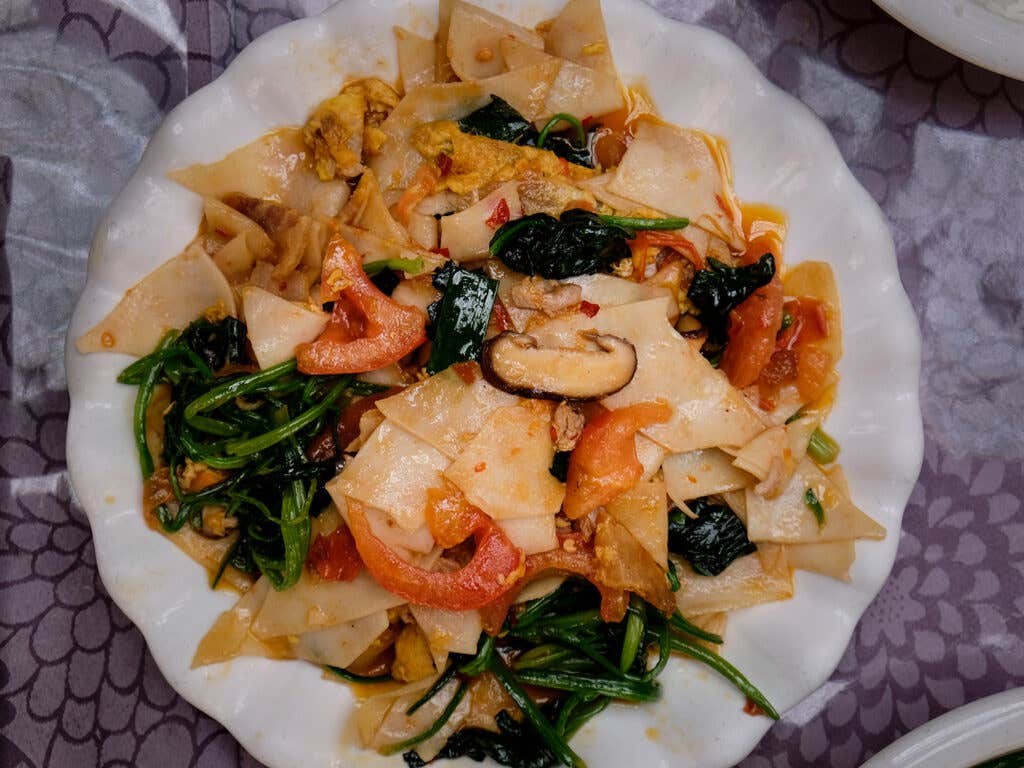
Yang Jian, a 38-year-old native of Kunming, has a small factory called Ying Fung Shao Erkuai just outside the city. The factory (one of five he has opened across Yunnan) is dedicated to making just the round, grillable version of erkuai—the kind I used to enjoy for breakfast.
Like Zao, Yang uses industrial-size steamers and grinders, which allow him to produce substantially more erkuai than he would be able to using traditional methods. While in his factory, I watched women in light-blue smocks, hairnets, and face masks roll out hundreds of perfectly round pieces of erkuai, each about 8 inches across. The factory also makes sauces to spread on top, as well as signs with the company’s logo, which Yang sells, in an arrangement similar to a franchise, to the owners of snack stalls all across town.
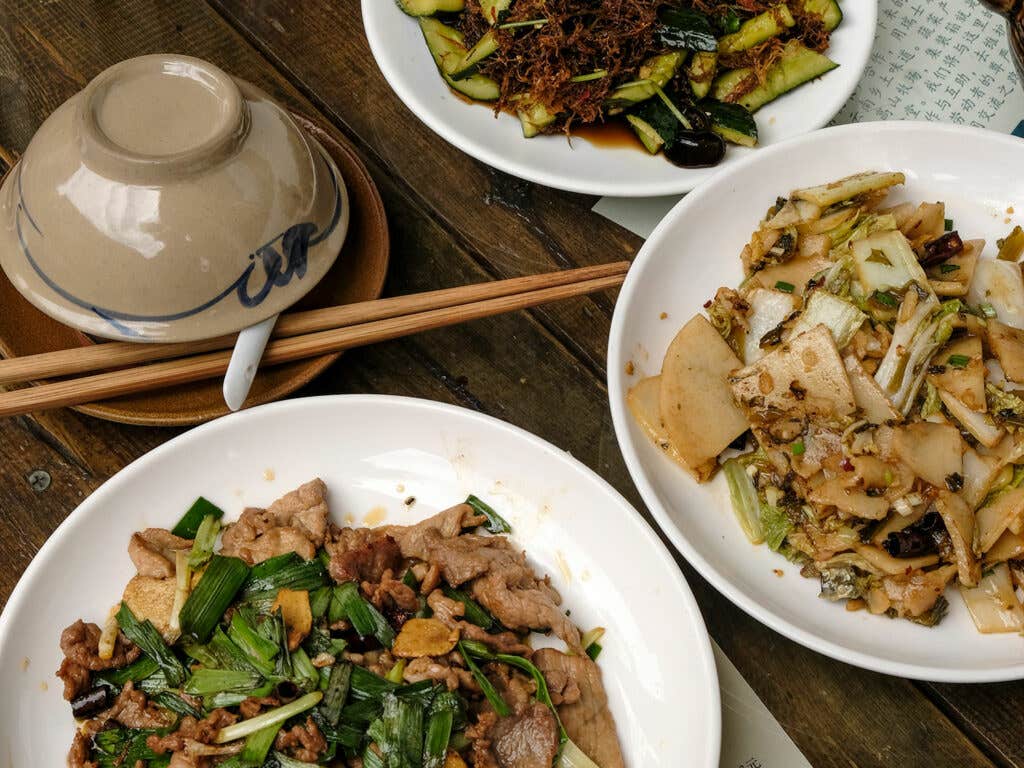
With approximately 300 retail locations across the province, Yang is also thinking about how to expand to other parts of China, though he hasn’t yet figured out if it’s feasible. Presumably, expanding would mean building factories in other cities, as he has done across Yunnan. He might just have a shot at turning one of Yunnan’s most ancient and venerable staples into a well-known dish throughout China and beyond.
Maybe in a few years, my husband and I will be able to hop in our car and drive down to Oakland’s Chinatown to pick up a freshly toasted piece of erkuai for breakfast, just like we used to.
Keep Reading
Continue to Next Story









